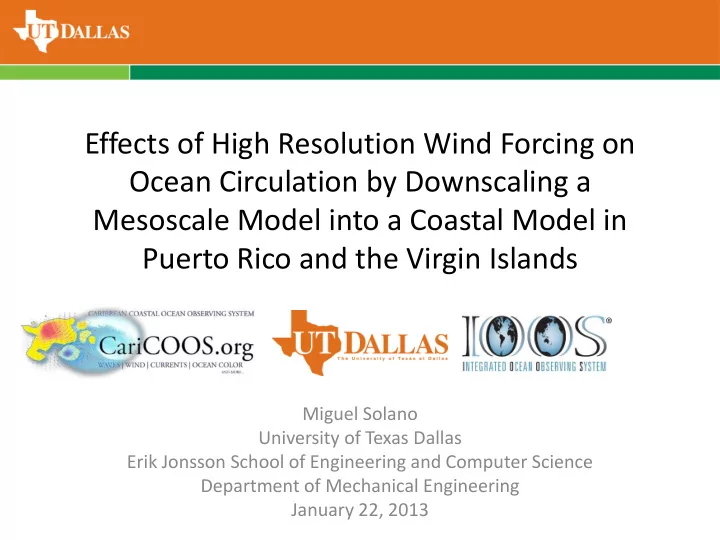

Effects of High Resolution Wind Forcing on Ocean Circulation by Downscaling a Mesoscale Model into a Coastal Model in Puerto Rico and the Virgin Islands Miguel Solano University of Texas Dallas Erik Jonsson School of Engineering and Computer Science Department of Mechanical Engineering January 22, 2013
Outline • Introduction – Motivation and background – Numerical Setup • Tide Validation • Wind Forcing • Ocean Currents/Temperature/Salinity distributions • Upwelling • Wind Effects on Ocean Currents • Conclusions • Future Work
Introduction • The purpose of the present work is to study the effects of high resolution wind forcing on ocean currents , sea surface temperature and salinity distribution. • To observe and quantify the effects of wind forcing the Regional Ocean Modeling System, a free-surface, terrain following, primitive equation ocean model is used. • The model uses an offline nesting approach to transmit boundary conditions from a mesoscale model ( AmSeas ) into a regional coastal model ( ROMS ). The mesoscale model is in turn nested in the global HYCOM model. Domain Bathymetry from Digital Elevation Model (DEM). Resolution: 1 arc-sec (~10m) Source: National Geophysical Date Center
Background and Motivation • Puerto Rico and the US Virgin islands are located in the continental shelf dividing the Caribbean Sea and the Atlantic Ocean. North of Puerto Rico we can find one of the deepest trenches in the world, with depths surpassing 7000 meters and extending about 800km. • Puerto Rico and the US Virgin Islands have some of the busiest ports in the world, relying heavily in the ocean for fisheries , tourism and importing goods. • Ocean circulation has a dramatic impact in marine ecosystems , wildlife and preservation of bio-luminescent bays. • Aid in weather safety and preparedness, oil spill management and search and rescue missions.
Numerical Set-Up Grid : ‒ Horizontal: 648 X 264 (1/162 degrees = 685m) ‒ Vertical: 32 sigma layers Initial and Boundary Conditions : ‒ Offline nesting: NCOM (~3.2km) -> ROMS (~685m) ‒ 3D velocity, temperature, salinity and SSH. ‒ Frequency: 3-hour interval. Forcing : ‒ Tide Forcing: OTPS (HARMONIC CONSTITUENTS) ‒ Surface: SST, heat flux, freshwater flux and shortwave radiation. (3-hour interval from AmSeas) Wind Forcing : ‒ Case 1: National Digital Forecast Database (NDFD) (~1.2km) ‒ Case 2: Coupled Ocean/Atmosphere Ocean Mesoscale Prediction System (COAMPS) (~3.2km)
Tides
Wind Stress • No nearshore wind data (3-8km) from COAMPS model • Wake around the island better solved by the NDFD • NDFD better captures wind divergence/convergence and drop-off caused by land NDFD does not “see” USVI, Vieques or Culebra Island, even though land area and mountain height is considerable (~1500ft) 𝑂 2 𝜐 𝑜𝑒𝑔𝑒 _ 𝑗 − 𝜐 𝑜𝑑𝑝𝑛 _ 𝑗 1 𝑆𝑁𝑇𝐹 = 𝜐 𝑜𝑑𝑝𝑛 𝑂 𝑗 =1
Ocean Currents
Temperature and Salinity Temperature Distribution Salinity Distribution
Vertical Section
Vertical Section
Ocean Currents ROMS using high resolution wind forcing (NDFD) vs AmSeas NCOM model • Right: Contours of root mean square error of U-component velocity [m/s] • Left: Contours of root mean square of V-component velocity [m/s]
Ocean Currents ROMS using high resolution wind forcing (NDFD) vs ROMS using medium resolution wind forcing (COAMPS) • Right: Contours of root mean square error of U-component velocity [m/s] • Left: Contours of root mean square of V-component velocity [m/s]
Ocean Currents ROMS using high resolution wind forcing (NDFD) vs AmSeas NCOM model • Right: Contours of root mean square error of U-component velocity [m/s] • Left: Contours of root mean square of V-component velocity [m/s]
Conclusions • High resolution wind forcing provides surface boundary conditions for the entire domain, including the near shore region where the mesoscale model fails to provide information. • Wake west of PR is better solved by high resolution (NDFD) atmospheric model (WRF) as well as wind drop-off and convergence/divergence. • UPWELLING CONCLUSION • Root mean square error contours of (U) velocity with different wind forcing show large differences in surface ocean currents in the near-shore regions, suggesting that high resolution wind forcing greatly affects zonal currents. Furthermore, contours of RMSE (V) velocity suggest the Island’s wake greatly affects ocean current direction west of the model domain. • ROMS high resolution model successfully downscales the NCOM mesoscale model. Increase in resolution allows for better tide current modeling as observed by RMSE contours of (V) velocity. Additionally,
Future Work • Use grid refinement (on-line nesting) in order to bring the solution from coastal to harbor scales. • Implement high resolution atmospheric model (WRF) and couple with ROMS model in order to quantify the effects of wind forcing in the coastal and harbor scales. • Take field measurements in the area in order to validate high resolution model.
Recommend
More recommend